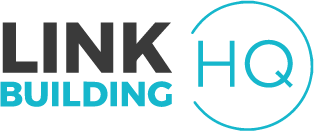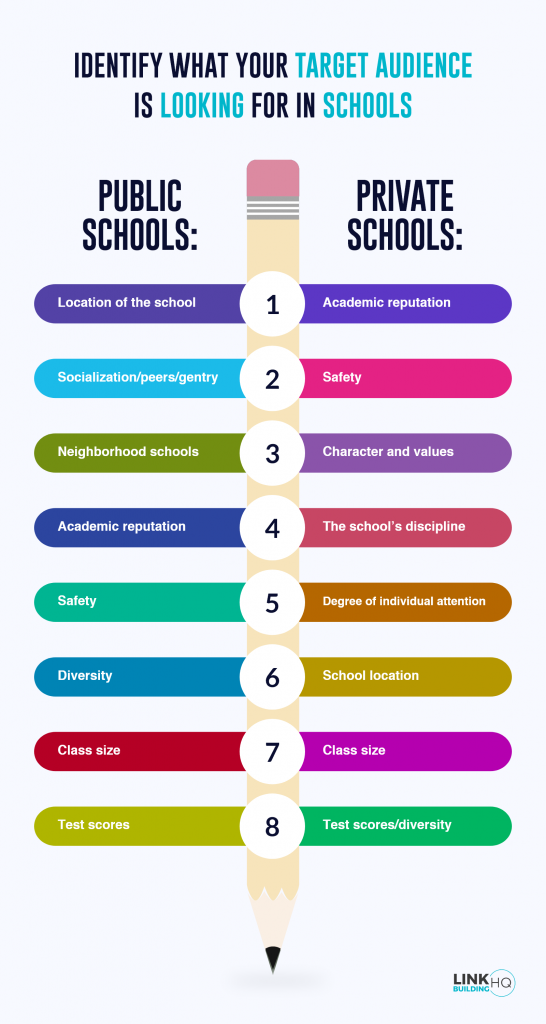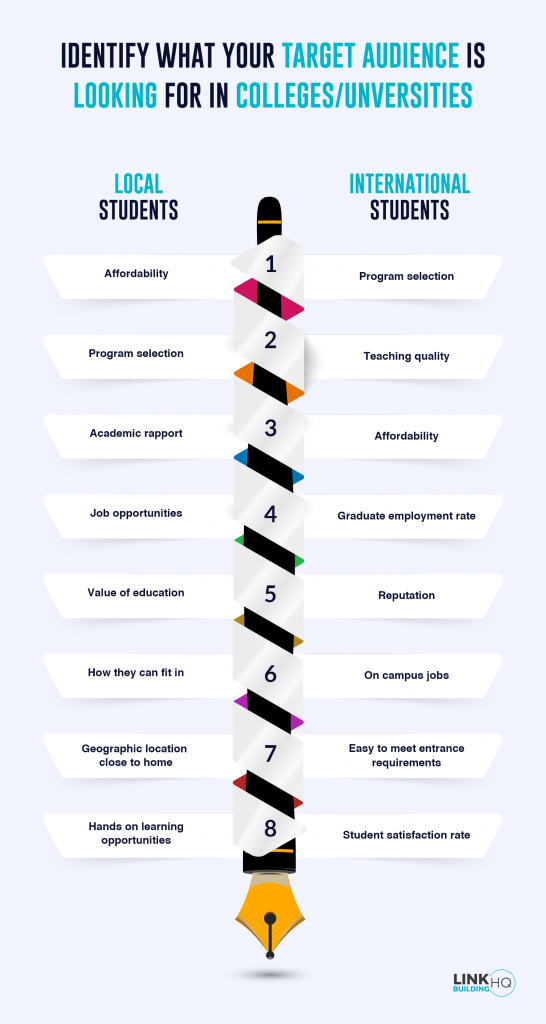Education SEO 101 – A difference in approaches
Education SEO – or SEO for any field is one of the best ways to bring leads and awareness. This form of digital marketing is organic and allows the intended target audience to land on the target pages.
As parents and students rely more on the internet to find the best place for studying, SEO takes more precedence than any other form of digital marketing.
What does the institution have to do? Nothing! Just a few short and easy moves allow the website to show on the top results of search engines – and let’s face it, when have we ever gone beyond the first page?
Diving deep into SEO in this field, we will talk about approaches according to the levels of education.
The audience for Education SEO
There are a few prerequisites for Education SEO. It’s best to start with knowing your audience. While there may be several subcategories, the below two will likely be the main ones.
Parents/guardians
Parents or guardians look for schools when they are enrolling a child. This target audience looks for K-12 schools for their children. Focusing on this audience for SEO can be crucial. These parents might be looking for private schools or even district schools that come under chosen public schools.
Students
Students usually look for schools when they are moving to higher education. Colleges and universities come under this target audience. This type of target audience looks for curricular co-curricular activities, faculty, and other forms of information.
Pro tip: Keep in mind that these students may come from all around the world.
Types of SEO for the educational field
Now that you know your main audience, you should know the type of SEO you should be using. Once again, you will find two types that are set in this field. You may be touching at least one of them or even both. Hence, you will see how SEO for universities is different.
Local SEO
If you use the ‘Local SEO‘ for educational institutions, you focus on the geographical approach. This means that you are most likely working to list your school or college under a particular radius.
So, how do you do local SEO? Keep reading to find out.
Here’s a hint: You use local keywords, reviews, and such.
Institutes that use local SEO under educational SEO are either community colleges or district public schools.
Traditional SEO
If you are not using Local SEO, then you are using traditional SEO. In some cases, you may even use both of them.
Traditional SEO is something you have heard about all the time. This type of SEO requires optimization of the institute to increase organic traffic. With traditional SEO, pages can rank at the top and become search engine-friendly. This allows more traffic that is interested in the business. Moreover, it gives out stronger leads.
Educational fields
It’s best to target SEO according to your institute than going for SEO without a strategy. There are two fundamental institutions. Let’s discuss them separately.
Schools
For school enrolments, parents and guardians make the decisions. Hence, you will have to target them with different approaches.
Simply put, you have to think like a person responsible for another person’s education to understand this target audience.
A study in 2016 showed that a higher number of parents in the United States preferred ‘chosen’ public schools. Gone are the days when parents would work only by the district. They are here to choose!
Parents were asked in a study in 2021 how they chose a school for their children.
SEO for schools
You know your target audience; you know your field. It is time to jump into SEO! Here are the best practices you can make.
- Identify your website
The first step to take is to identify your website. Keep in mind your target audience and know what they want. Now dig deep into your website. Does the website give ample information to keep the parent/guardian engaged? Does it invite the parent to visit? When you do this, you are already catering to the relevant information and are a step ahead. - Optimized
Will you ever spend time on a website that is not optimized? Will you spend time on a website that takes forever to load? Or if it is not adapted to your phone or tablet? Nobody has the time or patience! One of the main things you must do for SEO is to optimize the website and make it speedy and friendly to toggle around. - URL
Things are getting technical here because URLs are about technical SEO. Let us make it as simple as possible and present it to you. The website URL helps identify the address of a page of the website. Each URL has multiple parts. Hence, the perfect and apt URL helps the search engine know how to find a resource. Following the anatomy of the URL, you can benefit from it in various ways. Firstly, a simple and precise URL is readable by bots and even humans. Thus increasing visits to the website. URLs also help in ranking. How? A certain keyword in the URL can help improve the ranking, understandability, and hence, visibility. URLs also help make a great source for off-page SEO. A handsome-looking URL can serve as an anchor text on social, blogs, and any other off-page SEO spots. - Keyword
Oh, keywords, keywords, keywords! The salt to on-page SEO! Without it, food may just work, but it’ll be almost inedible. Coming back to the point! The right keywords, according to your school, your target audience, and the queries the parents have, are what help you rank. It helps you get leads too! You can use tools like AHREFs and SEMrush to find long-tail and short-tail keywords that satisfy queries. Want to know more? Check out this video we have on keyword research.
SEO for Higher education – Universities and colleges
Moving on to SEO for colleges and universities, your target audience will be different. Students themselves usually look for higher education. Exploring their fields and their choices are what your website and SEO approach should be all about. Remember that the audience here is also international students.
SEO practices for Higher education
Once again, you know the target audiences and what you offer. Get on the horse and begin your practices.
- Identify the student journey.
Before anything else, begin by making it easy for your student to choose your college for their higher education. Your first aim should be to make the student journey more evident and easier. Decide on how you will add hooks to let your students move forward. Make your website easy to toggle through each part of the journey. The journey should touch the interests of local and international students at the same time. Create content with guided keywords to cater to your students. Moreover, curate write-ups that help them satisfy their queries directly. By the end of their visit to your website, they should at least be able to list you down as an option. Moreover, they should not be pressured to visit your campus for some basic information. - Easy to toggle around
As a university or college, you may have a lot of information to present. And that’s alright! You have to cater to multiple different kinds of students. But how can you make it better and more accessible for each student while being SEO efficient? Make some awesome inbound links. Either add a section of ‘related pages’ or in use anchor text to hyperlink to related pages. This makes it easier for students to get all the information they need. A super bonus is the link-building you will be doing to make the website SEO efficient. - Blogs
Even here, keywords are the key to success. You can use short tail and basic keywords throughout your website. However, the best way is to answer questions in your blogs or even an FAQ section under each page. You see, colleges are a big decision. There is a lot of money involved, and let us not forget – the entire future of the person involved. Hence, students have a ton of questions. Use a tool like https://answerthepublic.com/ to find questions and long tail keywords. Therefore, ensure you answer them in the most transparent way possible. This will help students make informed decisions and make stronger leads. - Image Optimization
Adding images to your website can help make it look more pleasing and user-friendly. However, they are also the most common cause of slowing down your site speed, thus hurting your chances of ranking it. This can be solved by optimizing your images and adding alt text that helps describe the contents of the image in the text. - Multilingual SEO
As a university or college that invites international students as well, do not miss the chance for some multilingual SEO or global SEO. Try to make pages in contrasting languages. For example, if you offer a program in French and English, then find a way to translate the concerned page in both languages. While we are at it, avoid bot translations. They can… well backfire! Like it did in China. They translated the KFC slogan “its finger lickin’ good’ to ‘Eat your fingers off when it happened to Pepsi. They tried translating ‘Pepsi brings you back to life, and that changed to “Pepsi will bring your ancestors back from the dead”.
Final thoughts
SEO for educational institutions is a great way to bring new enrollments. It helps the audience make better and more informed decisions. Moreover, it helps institutions to be readily available to make a bigger impact in the educational world! SEO education just needs a little know-how, and you can achieve it at the right pace.









